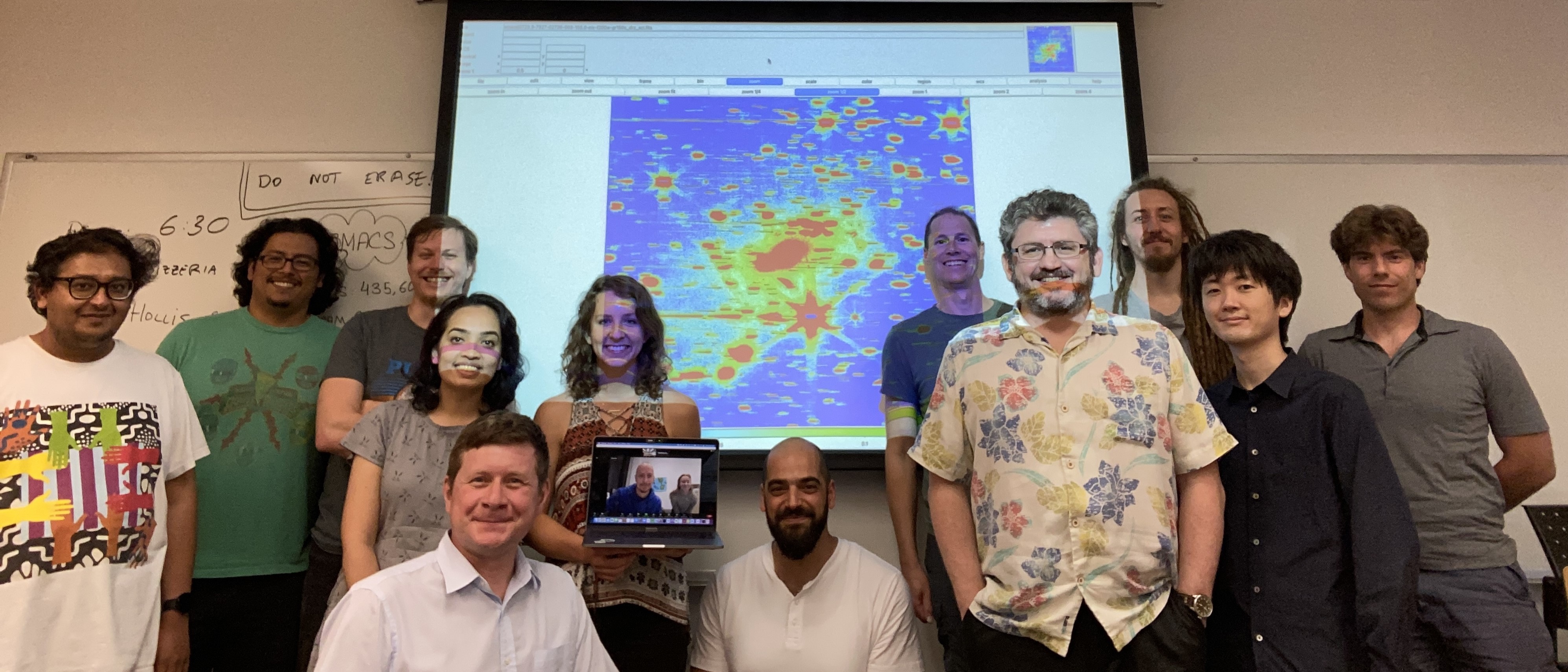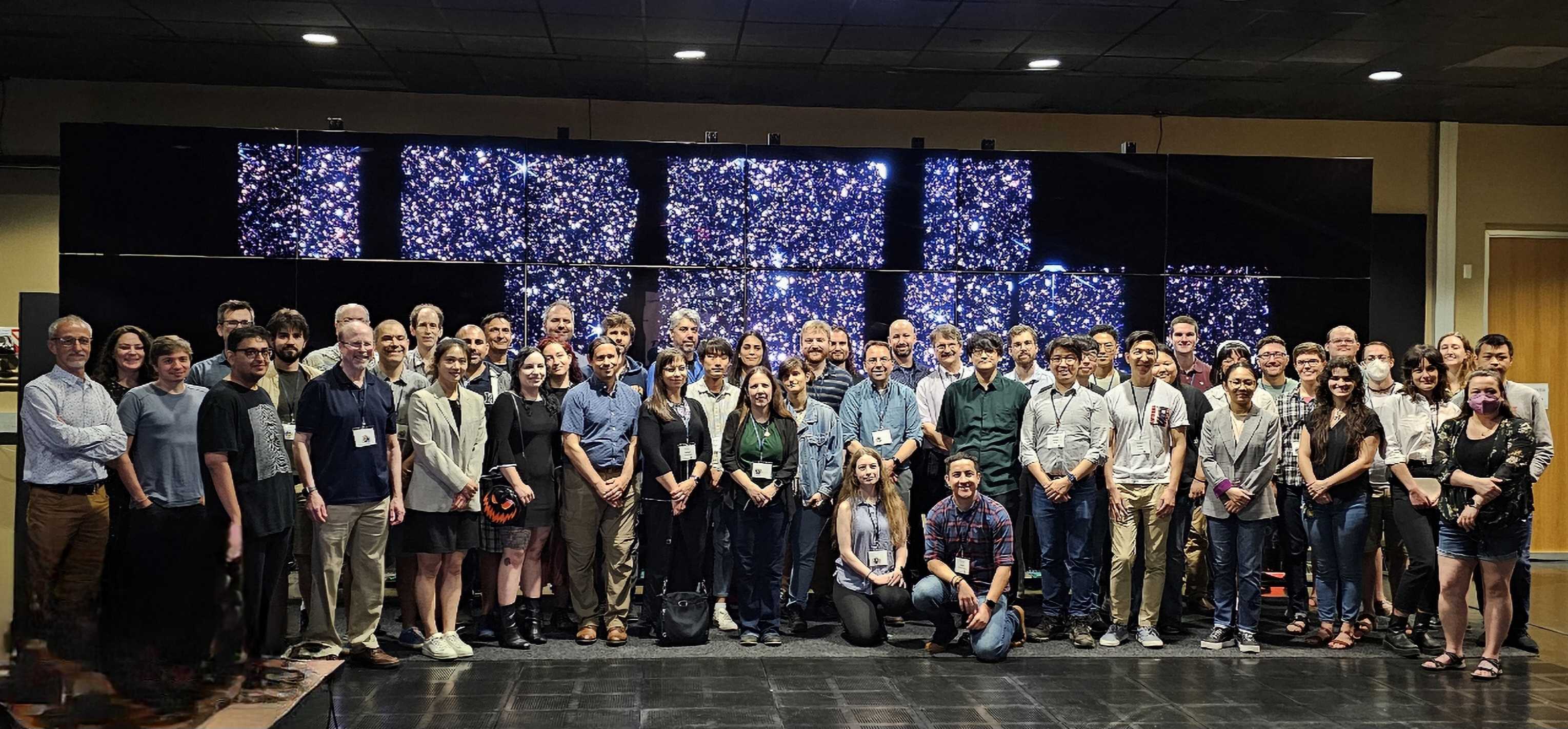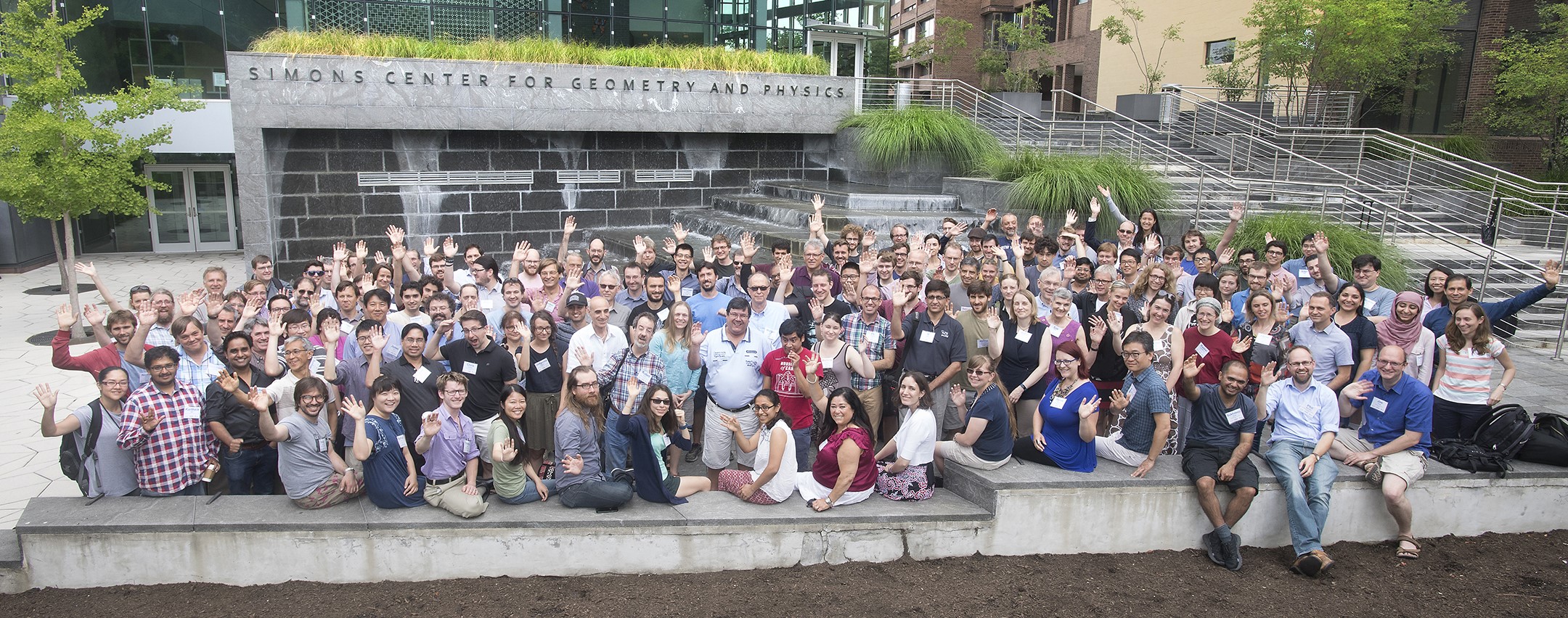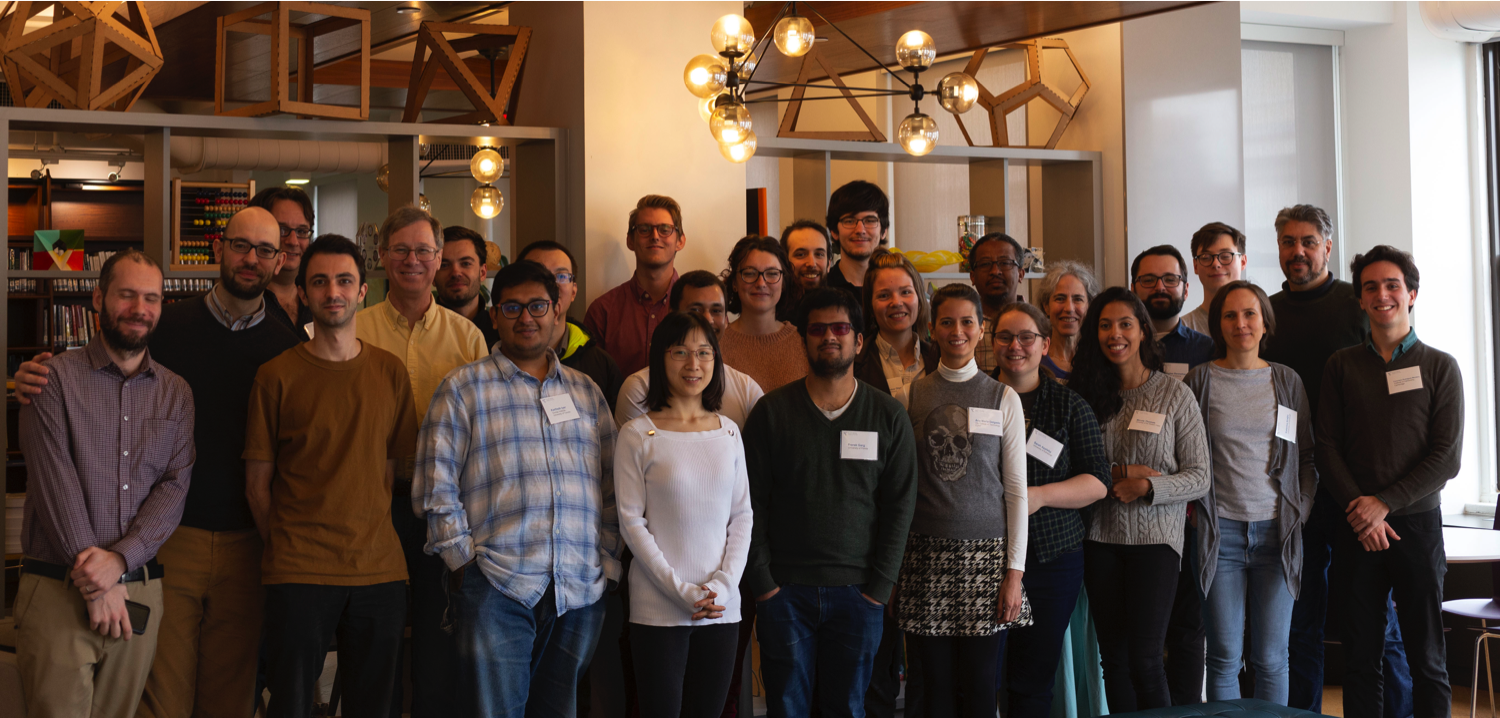Collaborations
As an astrophysicist, you get to work with some incredible people across the spectrum of theory, computation, statistics, and all the nuts and bolts of actually observing galaxies. Here are some of the groups that I am involved with and their primary science goals:
Observational¶
CANDELS¶
The Cosmic Assembly Near-infrared Deep Extragalactic Legacy Survey (CANDELS; PIs Faber & Ferguson) is the largest observing program undertaken with the Hubble Space Telescope. I helmed the SED fitting Working Group for a while (2019-2021), coordinating projects to recover physical properties and star formation histories for over 200,000 galaxies observed across the five CANDELS fields (GOODS-N, GOODS-S, EGS, UDS, PRIMER). During the pandemic, we started running a series of invited talks, which ultimately culminated in the creation of the Pan-survey SED forum. Read more about CANDELS here.
CANUCS¶
 The CAnadian NIRISS Unbiased Cluster Survey (CANUCS; PI Willott) is a large Cycle 1 GTO program observing 5 massive clusters with NIRCam, NIRISS and NIRSpec on the JWST to study distant galaxies magnified by gravitational lensing. I got involved in CANUCS during my time as a postdoc at the University of Toronto, and have been actively involved in a range of analyses characterizing the physical properties of distant galaxies magnified by lensing. This has led to exciting discoveries including the Sparkler galaxy, where we identified some of the most distant globular clusters ever observed.
The CAnadian NIRISS Unbiased Cluster Survey (CANUCS; PI Willott) is a large Cycle 1 GTO program observing 5 massive clusters with NIRCam, NIRISS and NIRSpec on the JWST to study distant galaxies magnified by gravitational lensing. I got involved in CANUCS during my time as a postdoc at the University of Toronto, and have been actively involved in a range of analyses characterizing the physical properties of distant galaxies magnified by lensing. This has led to exciting discoveries including the Sparkler galaxy, where we identified some of the most distant globular clusters ever observed.
CEERS¶
 The Cosmic Evolution Early Release Science Survey (CEERS; PI Finkelstein) is a ERS program observing a large patch (over 100 sq. arcmin) of the EGS field wuth NIRCam, MIRI and NIRSpec on the JWST. Making use of the overlap with CANDELS, CEERS has been responsible for many of JWST's most exciting discoveries.
The Cosmic Evolution Early Release Science Survey (CEERS; PI Finkelstein) is a ERS program observing a large patch (over 100 sq. arcmin) of the EGS field wuth NIRCam, MIRI and NIRSpec on the JWST. Making use of the overlap with CANDELS, CEERS has been responsible for many of JWST's most exciting discoveries.
LSST-DESC¶
 The Vera C. Rubin observatory Legacy Survey of Space and Time - Dark Energy Science Collaboration (LSST-DESC) will use the Rubin Observatory in Chile to make some of the most precise measurements of fundamental cosmological parameters to date. I've been part of DESC's photo-z working group for a while, and served as the Junior DESC Organization (JuDO) co-lead for almost three years during the pandemic.
The Vera C. Rubin observatory Legacy Survey of Space and Time - Dark Energy Science Collaboration (LSST-DESC) will use the Rubin Observatory in Chile to make some of the most precise measurements of fundamental cosmological parameters to date. I've been part of DESC's photo-z working group for a while, and served as the Junior DESC Organization (JuDO) co-lead for almost three years during the pandemic.
GARDEN & MEADOW¶
Galaxies at All Redshifts Deciphered and Explained with the NIRSpec MSA (GARDEN; PI Kassin) is an observing program using the multi-shutter array on JWST's NIRSpec to combine spatially resolved observations of large objects with deep spectroscopic observations of faint, high-redshift galaxies. MEADOW is an extension of GARDEN using high-resolution spectroscopy to measure the angular momentum of high-z galaxies along large scale structures.
Theory / modeling¶
IQ Collaboratory¶
The IQ (Isolated and Quiescent) Collaboratory is a collaboration aimed at studying the quenching mechanisms of galaxies across a range of cosmological simulations, and propagate this all the way to synthetic observations with realistic systematics and selection effects, that can then be compared with actual observations from galaxy surveys. This is where I first came across the phrase 'forward modeling' and saw a concerted effort to put multiple simulations on the same footing.
SIMBA¶
 The SIMBA family of simulations explores the co-evolution of the stars, gas and black holes in galaxies using a meshless hydrodynamic setup. Working with folks in SIMBA, I study how different physical processes leave imprints in temporal records of galaxy evolution. With SIMBA, my work focuses particularly on quantifying signatures of AGN feedback and studying the size evolution of distant galaxies. This theoretical work complements my observational studies by helping us understand the underlying physics driving galaxy evolution.
The SIMBA family of simulations explores the co-evolution of the stars, gas and black holes in galaxies using a meshless hydrodynamic setup. Working with folks in SIMBA, I study how different physical processes leave imprints in temporal records of galaxy evolution. With SIMBA, my work focuses particularly on quantifying signatures of AGN feedback and studying the size evolution of distant galaxies. This theoretical work complements my observational studies by helping us understand the underlying physics driving galaxy evolution.
CAMELS¶
The Cosmology and Astrophysics with MachinE Learning Simulations (CAMELS) and DaRk mattEr and Astrophysics with Machine learning and Simulations (DREAMS) projects tackle the extremely challenging question of how varying cosmology and feedback affect the various observables we use to study galaxy evolution and constrain cosmology. They do this by running many realizations of hydrodynamical models like IllustrisTNG, SIMBA, EAGLE, ASTRID and more, while varying these parameters and producing full (extremely large) datasets showing how galaxies evolve in these multiverses. I am currently working on quantifying the SFH-feedback connection in the CAMELS models, and look forward to working with DREAMS in the future.
Learning the Universe¶
The Simons Collaboration on Learning the Universe (LtU) is a large group of theorists and simulators working on improving the way we run large cosmological simulations of the universe and compare them to observations. We do this by improving sub-grid prescriptions that come from high-res simulations, accelerate forward modeling using emulators, and develop fast inference methods to sample complex, multidimensional spaces while comparing with observations. As a member of the synthetic observations and inference working groups, I work on creating realistic mock observations from theoretical models.
AI / ML / method development¶
UniverseTBD¶
UniverseTBD grew out of conversations between Ioana Ciucă and other participants at the Data Driven Astronomy conference at KITP, Santa Barbara. This was around the time GPT-4 was coming out, and a bunch of us had early access and were playing around with it for different applications. For me, it was better literature surveys, while for Jo it was hypothesis generation. The interest snowballed, we made UTBD, and have been growing ever since, exploring applications of foundation models and large language models in astronomical research. Our work focuses on developing tools that make astronomical research more accessible and efficient, including projects like pathfinder that help researchers navigate the scientific literature. While doing this, our mission is also to connect early-career researchers to domain experts that can provide direction and feedback while exploring these topics.
J-HIVE¶
JWST's Homogeneous Information-rich Visualization of Extragalactic datasets (J-HIVE) is an effort to consolidate all the public imaging datasets from JWST so far, run a homogeneous analysis on them to estimate their physical properties, and make the whole thing accessible to the public. The motivation behind this effort - which grew out of work that Lamiya Mowla and I have been involved with since JWST's first data were released - comes from a desire to make JWST data accessible to everyone, not just those in large collaborations, in a reasonably science-ready manner. We are also exploring various machine-learning techniques to organize galaxies by spatial and spectral similarity to create improved selection techniques to identify galaxy populations and interesting outliers.
Pan-survey SED forum¶
Spectral Energy Distribution (SED) modeling remains one of our best methods to infer the physical properties of distant galaxies. As JWST data observes galaxy spectra with unprecedented depth, the data quality is good enough for us to start questioning some of the assumptions we make while fitting these spectra, which are often based on calibrations from local observations that might be quite different from the conditions in the early universe. To do this more effectively and encourage cross-communication between different groups and collaborations, the pan-survey SED forum brings together researchers working on galaxy evolution across different wavelengths and epochs to discuss the state-of-the-art when it comes to SED fitting.